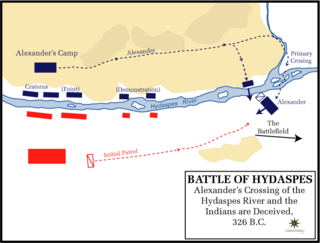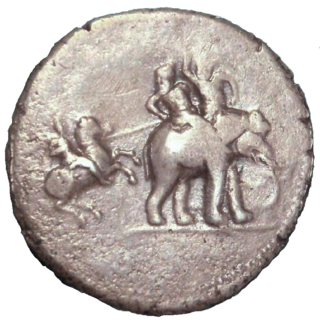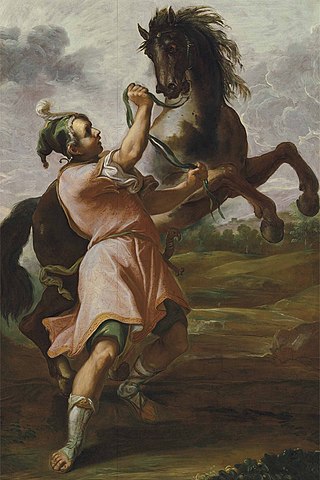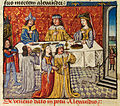
Alexander III of Macedon, commonly known as Alexander the Great, was a king of the ancient Greek kingdom of Macedon. He succeeded his father Philip II to the throne in 336 BC at the age of 20 and spent most of his ruling years conducting a lengthy military campaign throughout Western Asia and Egypt. By the age of 30, he had created one of the largest empires in history, stretching from Greece to northwestern India. He was undefeated in battle and is widely considered to be one of history's greatest and most successful military commanders.

Darius III was the last Achaemenid King of Kings of Persia, reigning from 336 BC to his death in 330 BC.
This article concerns the period 339 BC – 330 BC.

This article concerns the period 329 BC – 320 BC.

Year 326 BC was a year of the pre-Julian Roman calendar. At the time, it was known as the Year of the Consulship of Visolus and Cursor. The denomination 326 BC for this year has been used since the early medieval period, when the Anno Domini calendar era became the prevalent method in Europe for naming years.

Artaxerxes I was the fifth King of Kings of the Achaemenid Empire, from 465 to December 424 BC. He was the third son of Xerxes I.

Cyrus the Younger was an Achaemenid prince and general. He ruled as satrap of Lydia and Ionia from 408 to 401 BC. Son of Darius II and Parysatis, he died in 401 BC in battle during a failed attempt to oust his elder brother, Artaxerxes II, from the Persian throne.

Porus or Poros was an ancient Indian king whose territory spanned the region between the Jhelum River (Hydaspes) and Chenab River (Acesines), in the Punjab region of the Indian subcontinent. He is only mentioned in Greek sources. Credited to have been a legendary warrior with exceptional skills, Porus unsuccessfully fought against Alexander the Great in the Battle of the Hydaspes. In the aftermath, an impressed Alexander not only reinstated him as his satrap but also granted him dominion over lands to the south-east extending as far as the Hyphasis (Beas). Porus reportedly died sometime between 321 and 315 BC.

The Battle of Cunaxa was fought in the late summer of 401 BC between the Persian king Artaxerxes II and his brother Cyrus the Younger for control of the Achaemenid throne. The great battle of the revolt of Cyrus took place 70 km north of Babylon, at Cunaxa, on the left bank of the Euphrates. The main source is Xenophon, a Greek soldier who participated in the fighting.

Bessus or Bessos, also known by his throne name Artaxerxes V, was a Persian satrap of the eastern Achaemenid satrapy of Bactria, as well as the self-proclaimed King of Kings of the Achaemenid Empire from 330 to 329 BC.

Bucephalus or Bucephalas was the horse of Alexander the Great, and one of the most famous horses of classical antiquity. Ancient historical accounts state that Bucephalus's breed was that of the "best Thessalian strain", and that he died in what is now Punjab, Pakistan, after the Battle of the Hydaspes in 326 BC. Alexander was so grieved at the loss of his horse that he named one of the many cities he founded after him, as Alexandria Bucephalous.

The wars of Alexander the Great were a series of conquests that were carried out by Alexander III of Macedon from 336 BC to 323 BC. They began with battles against the Achaemenid Persian Empire, then under the rule of Darius III of Persia. After Alexander's chain of victories against Achaemenid Persia, he began a campaign against local chieftains and warlords that stretched as far from Greece as the region of Punjab in South Asia. At the time of his death, he ruled over most regions of Greece and the conquered Achaemenid Empire ; he did not, however, manage to conquer the Indian subcontinent in its entirety according to his initial plan. Despite his military accomplishments, Alexander did not provide any stable alternative to the rule of the Achaemenid Empire, and his untimely death threw the vast territories he conquered into a series of civil wars, commonly known as the Wars of the Diadochi.

The Battle of the Hydaspes also known as Battle of Jhelum, or First Battle of Jhelum, was fought between Alexander the Great and Porus in May of 326 BC. It took place on the banks of the Hydaspes River in Punjab, as part of Alexander's Indian campaign. In what was possibly their most costly engagement, the Macedonian army secured a decisive victory over the Pauravas and captured Porus. Large areas of Punjab were subsequently absorbed into the Macedonian Empire; Porus was reinstated as the region's ruler after Alexander, having developed a newfound respect for the fierce resistance put up by Porus and his army, appointed him as a satrap.

The Pauravas were an ancient tribe in the Indus valley, to which King Porus may have belonged.

Parysatis was a Persian queen, consort of Darius II and had a large influence during the reign of Artaxerxes II.
Boukephala and Nikaia (Νίκαια) were two cities founded by Alexander the Great on either side of the Hydaspes during his invasion of the Indian subcontinent. The cities, two of many founded by Alexander, were built shortly after his victory over the Indian king Porus at the Battle of the Hydaspes in early 326 BC.

The Twenty-seventh Dynasty of Egypt, also known as the First Egyptian Satrapy, was a province (Satrapy) of the Achaemenid Persian Empire between 525 BC and 404 BC. It was founded by Cambyses II, the King of Persia, after the Battle of Pelusium and the Achaemenid conquest of Egypt, and his subsequent crowning as Pharaoh of Egypt. It was disestablished upon the rebellion and crowning of Amyrtaeus as Pharaoh. A second period of Achaemenid rule in Egypt occurred under the Thirty-first Dynasty of Egypt.

The Indian campaign of Alexander the Great began in 327 BC and lasted until 325 BC. After conquering the Achaemenid Persian Empire, the Macedonian army undertook an expedition into the northwestern Indian subcontinent. Within two years, Alexander expanded the Macedonian Empire to include present-day Punjab and Sindh in what is modern-day Pakistan, surpassing the earlier frontiers that had been established by the Persian conquest of the Indus Valley.

The Achaemenid Empire or Achaemenian Empire, also known as the First Persian Empire, was the ancient Iranian empire founded by Cyrus the Great of the Achaemenid dynasty in 550 BC. Based in modern-day Iran, it was the largest empire by that point in history, spanning a total of 5.5 million square kilometres. The empire spanned from the Balkans and Egypt in the west, West Asia as the base, the majority of Central Asia to the northeast, and parts of South Asia to the southeast.

Porus is a historical drama television series based on the Battle of the Hydaspes, visualizing the lives of Indian warrior and ruler Porus, King of the Paurava Kingdom and Alexander the Great, King of Macedonia. It aired from 27 November 2017 till 13 November 2018 on Sony Entertainment Television. Another historical drama Chandragupta Maurya replaced it.

















































